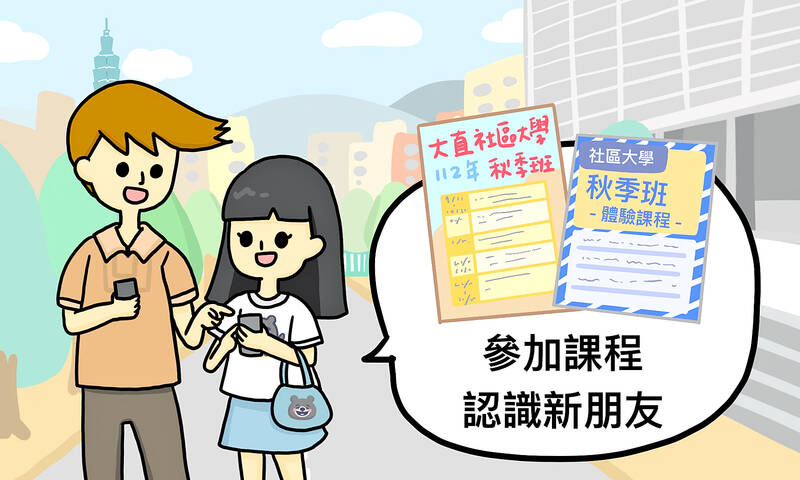對話 Dialogue
馬克:小實,我想問問你,你都是怎麼認識新朋友的?
Mǎkè:Xiǎoshí, wǒ xiǎng wèn wèn nǐ, nǐ dōu shì zěnme rènshì xīn péngyǒu de?

小實:怎麼突然這麼問?我記得你在臺灣的朋友很多啊!
Xiǎoshí:Zěnme túrán zhème wèn? Wǒ jìde nǐ zài Táiwān de péngyǒu hěnduō a!
馬克:是沒錯啊,只是我還想多認識一些臺灣人。
Mǎkè:Shì méicuò a, zhǐshì wǒ hái xiǎng duō rènshì yìxiē Táiwānrén.
小實:嗯……你試過現在很流行的網路交友嗎?
Xiǎoshí:En ... nǐ shìguò xiànzài hěn liúxíng de wǎnglù jiāoyǒu ma?
馬克:我試過,但是每次見到網友都覺得和網路上的感覺不一樣。
Mǎkè:Wǒ shìguò, dànshì měi cì jiàndào wǎngyǒu dōu juéde hàn wǎnglù shàng de gǎnjué bù yíyàng.
小實:這樣啊……還是你有興趣參加社區裡的課程嗎?
Xiǎoshí:Zhèyàng a... háishì nǐ yǒu xìngqù cānjiā shèqū lǐ de kèchéng ma?
馬克:喔?我看過一些廣告,好像有運動、藝術的各種主題?
Mǎkè:Ō ? Wǒ kànguò yìxiē guǎnggào, hǎoxiàng yǒu yùndòng, yìshù de gèzhǒng zhǔtí?
小實:是啊,你可以一邊學習新知識,一邊認識新朋友。
Xiǎoshí:Shì a, nǐ kěyǐ yìbiān xuéxí xīn zhīshì, yìbiān rènshi xīn péngyǒu.
馬克:聽起來很不錯耶,我去找找我們那個社區的課程。
Mǎkè:Tīngqǐlái hěn búcuò yé, wǒ qù zhǎo zhǎo wǒmen nàge shèqū de kèchéng.
小實:好的,祝你順利交到更多臺灣朋友喔!
Xiǎoshí:Hǎo de, zhù nǐ shùnlì jiāo dào gèngduō Táiwān péngyǒu ō!
翻譯 Translation
Mark: Xiaoshi, I want to ask you, how do you usually make new friends?
Xiaoshi: Why are you suddenly asking this? I remember you have a lot of friends in Taiwan!
Mark: That’s true, but I would like to meet more Taiwanese.
Xiaoshi: Hmm... Have you tried the popular trend of making friends online?
Mark: I have, but every time I meet someone on the Internet, it feels different than meeting in person.
Xiaoshi: I see... Are you interested in joining community courses?
Mark: Oh? I’ve seen some ads for those, like various themes such as sports and art?
Xiaoshi: Yes, you can learn new things while getting to know new people.
Mark: That sounds great. I’ll look for courses in our community.
Xiaoshi: Alright, I hope you get to make more friends!
單字片語 Vocabulary
1. 突然 (túrán) suddenly
2. 流行 (liúxíng) popularity
3. 交友 (jiāoyǒu) to make friends
4. 網友 (wǎngyǒu) netizen
5. 社區 (shèqū) community
6. 藝術 (yìshù) art
7. 主題 (zhǔtí) theme
8. 知識 (zhīshì) knowledge
9. 課程 (kèchéng) course
教材音檔 Audio Files
教材影片 Video Files:
https://www.instagram.com/celc.nou_tw/guide/_/17999106352646292/
實踐大學華語中心提供
By Shih Chien University Chinese Language Center: https://chineseusc.com/

In most cities, food waste is often regarded as one of the most troublesome types of waste: it has a high moisture content, spoils easily and produces strong odors. If not handled properly, it can cause serious sanitation and environmental problems. From the perspective of the circular economy, however, food waste is not “useless leftovers,” but rather an organic resource that has yet to be effectively utilized. The core principle of the circular economy is to break away from the linear model of “production–consumption–disposal,” allowing resources to circulate repeatedly within a system and extending their useful life. Food waste occupies a

A: Google has unveiled its 2025 Year in Search chart. No. 10 to No. 6 are: Typhoon Podul, Chinese drama “Love’s Ambition,” tariffs, US President Donald Trump and singer Khalil Fong’s death. B: Wow, actress Rosy Zhao’s new drama is so popular. So what are the top five? A: No. 5 to No. 1 are: Gemini, hanzii.net, NT$10,000 cash handout, entertainer Big S’ death and earthquakes. B: Hasn’t Trump topped this year’s most-searched people chart? A: Yup, and he’s closely followed by cheerleader GuoGuo Chiang at No. 2, whose husband Zack Fanchiang is also at No. 8. Apparently, people are curious about her extramarital

In June, headlines shocked the art world when a visitor damaged a 17th-century painting at the Uffizi Galleries in Florence, Italy, while posing for a photograph. This was not an isolated event. Recently, similar disasters have been reported worldwide, from a child damaging a Mark Rothko painting to a tourist breaking an exhibit by pretending to sit on it. Such incidents highlight why museum etiquette is increasingly crucial. First, we must recognize that art and historical objects are fragile. Once damaged, they may never regain their original condition. Many common actions, though harmless at first glance, can have grave consequences. For

對話 Dialogue 清清:後天就是聖誕節了! Qīngqing: Hòutiān jiùshì Shèngdàn jié le! 華華:但也是我們的行憲紀念日,從今年開始又恢復放假了。 Huáhua: Dàn yě shì wǒmen de Xíngxiàn Jìniànrì, cóng jīnnián kāishǐ yòu huīfù fàngjià le. 清清:只有一天吧?沒有彈性放假,對嗎? Qīngqing: Zhǐ yǒu yì tiān ba? Méiyǒu tánxìng fàngjià, duì ma? 華華:對,就是星期四休一天。 Huáhua: Duì, jiùshì xīngqísì xiū yì tiān. 清清:你那天有什麼安排? Qīngqing: Nǐ nèitiān yǒu shénme ānpái? 華華:我想吃聖誕大餐,然後跟家人交換禮物。 Huáhua: Wǒ xiǎng chī Shèngdàn dàcān, ránhòu gēn jiārén jiāohuàn lǐwù. 清清:聽說樓下的部門也辦交換禮物派對,我們要不要也辦一個? Qīngqing: Tīngshuō lóuxià de bùmén yě bàn jiāohuàn lǐwù pàiduì, wǒmen yào búyào yě bàn yí ge? 華華:喔!好啊!那你問問大家的意見吧! Huáhua: Ō! Hǎo a! Nà nǐ wènwen dàjiā de yìjiàn ba! 翻譯 Translation Qingqing: The day after tomorrow is Christmas. Huahua: It’s also Constitution Day in Taiwan. Starting this year, we get the day off again. Qingqing: